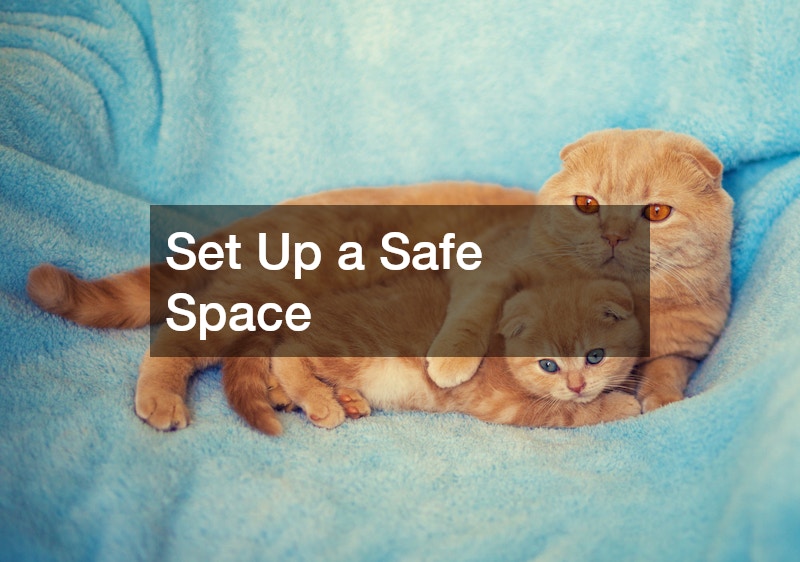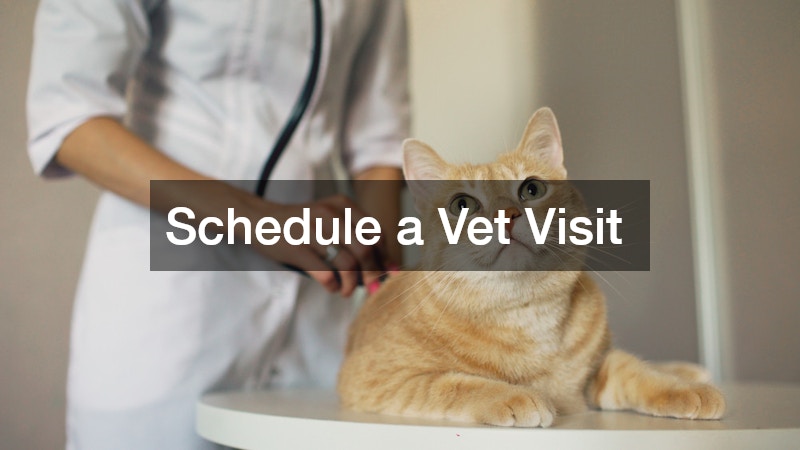Welcoming a new cat into your home can be an exciting adventure. To ensure a smooth transition for both you and your furry friend, it’s important to prepare your home accordingly. This article will guide you through essential tips and considerations when preparing your home for a cat.

Set Up a Safe Space
Creating a safe space for your new cat is paramount in ensuring they feel secure and comfortable. Begin by identifying a quiet room that will serve as your cat’s initial haven. This helps them acclimate to their surroundings without feeling overwhelmed by preparing your home for a cat.
Consider the floor type in your chosen room. While hardwood or laminate may seem practical, carpet installation can provide added comfort and warmth. Select the best option for your needs, keeping potential accidents in mind.
Make sure the space is free of hazards by checking for loose wires, toxic plants, and small items. It’s crucial that this area remains a stress-free zone where your cat can retreat at any time.
Get a Comfortable Bed
Providing a comfortable bed is essential for your cat’s rest and well-being. Look for a bed that is cozy and appropriately sized for your feline friend. The bed should be placed in a quiet corner of the safe space, reinforcing the notion that it’s a sanctuary just for them.
Choose a material that is both durable and easy to clean. Cats are naturally drawn to soft textures, so consider plush fabrics that offer the snuggly comfort they crave. Placement is key; keep it away from high-traffic areas to minimize disruptions and create a truly restful space.
Remember that cats enjoy variety in their sleeping environments. You might want to invest in multiple beds or different types of sleeping spots. Options like window perches or heated beds can add versatility and a touch of luxury to their resting times, helping them feel more at ease with their new surroundings.
Provide Litter Boxes
One of the most crucial preparations when preparing your home for a cat is setting up litter boxes. Ideally, there should be one litter box per cat, plus an extra, to prevent territorial issues and ensure comfort. Placement is important; litter boxes should be in quiet, accessible areas, but not too close to their feeding stations.
Consider the type of flooring in areas where you plan to place litter boxes. Flooring that is easy to clean, like tile or vinyl, can help manage any stray litter or accidents. Some homeowners prefer to place the box in their basement or a guest room designed to have a dedicated litter containment system.
The choice of litter and type of box can impact your cat’s willingness to use it. Testing different types can help you find what works best for your cat. Maintaining a clean box is critical, as cats are fastidious creatures, and neglecting this can lead to behavioral issues.

Stock Up on Cat Food
Proper nutrition is fundamental to your cat’s health and happiness. When preparing your home for a cat, research and stock up on high-quality cat food that meets all their dietary needs. It’s advisable to consult your veterinarian during a visit to a veterinary clinic for dietary recommendations.
Think of convenient storage solutions for your cat food. Opt for airtight containers to keep the food fresh and place them on residential countertops within easy reach. This helps ensure feeding your cat fits seamlessly into your daily routine.
Cats can be finicky eaters, and sudden changes in diet can upset their stomachs. Introduce any changes gradually, mixing new food with the old to ease the transition. Ensuring your cat has consistent access to nutritious food plays a vital role in their adjustment to their new environment.
Choose Appropriate Toys
Toys are an essential aspect of your cat’s enrichment and mental stimulation. Selecting appropriate toys can encourage natural behaviors like hunting, chasing, and pouncing, thereby helping your cat adjust to its new home. It’s vital to have a variety of toys to keep their interest, ranging from soft plush toys to interactive laser pointers.
When discussing your pet’s health with veterinarians, they might emphasize the importance of safe, non-toxic materials in pet toys. Avoid toys that could easily break apart and become choking hazards. Durable options with no small detachable parts are often recommended to prevent risks.
Your presence during play sessions can be as crucial as the toys themselves. Playing strengthens your bond with your new pet and provides them with necessary social interaction. Regular playtime can alleviate stress and provide the physical activity your cat needs to feel confident and content in their new home.
Install Scratching Posts
Cats have a natural instinct to scratch, and providing appropriate outlets can save your furniture and keep your cat happy. Scratching posts are an effective solution that must be tall enough to allow your cat a full vertical stretch. They serve to file down claws, mark territory, and relieve stress.
Location is key; place scratching posts where your cat is likely to spend most of their time, like near favorite sleeping or play areas. Scratching sessions contribute to your cat’s exercise routine, an essential component of their wellness.
Adding multiple scratching surfaces and textures can entice your cat and encourage appropriate scratching behavior when preparing your home for a cat. Cats may enjoy sisal rope, cardboard, or carpeted posts, so introducing a mix can satisfy their preferences. Installing these posts helps in the smooth transition of making your home a pet-friendly zone.

Remove Toxic Plants
When adopting a cat, it’s essential to create a safe environment, and one key aspect of this is removing toxic plants from your home. Many common houseplants can pose serious health risks to cats if ingested. Popular plants such as lilies, aloe vera, philodendron, and pothos can cause symptoms ranging from mild irritation to severe organ failure.
Lilies, in particular, are extremely toxic to cats, potentially causing kidney failure even in small amounts. Aloe vera, often praised for its healing properties, can lead to vomiting and diarrhea in cats if ingested. Philodendron and pothos, while popular for their easy care, contain calcium oxalates that can cause oral irritation, drooling, and difficulty swallowing.
To protect your cat, it’s crucial to research all the plants in your home and either remove or relocate those that are harmful. If you still want greenery in your home, consider cat-safe alternatives such as spider plants, bamboo, or Boston ferns. You can also create a designated space for your cat with pet-friendly plants like cat grass or catnip, which not only are safe but also enrich their environment. Taking these steps will help ensure your cat’s safety and allow you to enjoy a happy, healthy relationship.
Invest in a Cat Tree
When adopting a cat, investing in a cat tree is one of the best ways to create an enriching, safe, and stimulating environment for your new feline friend. Cat trees serve multiple purposes, offering both entertainment and comfort while also helping to protect your furniture from damage. Cats have natural instincts to climb, scratch, and perch in high places, and a cat tree satisfies these needs in a safe, designated area.
Cats love being up high, as it gives them a sense of security and control over their surroundings. A tall cat tree with multiple platforms allows your cat to observe its environment, rest comfortably, and feel safe. The height of the tree can also help your cat establish its own territory, especially if you have multiple pets, which can reduce stress and territorial behavior.
Cat trees also offer a place for exercise and play, which is especially important for indoor cats that might not have many outlets for physical activity. Many trees come with built-in toys, tunnels, and hideaways, keeping your cat engaged and active. These features help prevent boredom, which can lead to behavioral issues such as excessive scratching or biting.
Secure Hazardous Areas
Ensuring your home is free of hazards is a vital step in preparing your home for a cat. Common household items such as cleaning supplies, medications, and sharp objects should be stored securely out of reach. Securing hazardous areas helps prevent accidental ingestion or injury, creating a safer home for your pet.
Consider installing child-proof locks on cabinets or doors that contain dangerous substances. For broader areas, engaging a fence company to install gates or barriers can help demarcate off-limits zones. Safety is paramount not just for your new pet, but for everyone sharing the environment.
Outdoor spaces also require attention, as they can host various dangers. Before allowing your feline friend to explore the great outdoors, fence any perimeter completely.

Set Up a Feeding Station
A designated feeding station provides structure and security for your cat’s meal times. When preparing your home for a cat, choose an area that is quiet, away from household commotion, and free from other pets to make sure your cat feels safe while eating. This homely consistency is crucial for their successful adaptation to living with you.
While setting this up, visit a flooring store and choose a material that allows for easy cleaning of accidental spills or food scatter. Consider using a slightly elevated platform for petite areas to make meal times more comfortable for your cat. A neat and clean eating space fosters better feeding habits and well-being.
Experimenting with varied types of bowls can appeal to your cat’s preferences, whether that’s stainless steel, ceramic, or BPA-free plastic. Fresh water must always be available alongside their meals to maintain adequate hydration. Keeping these essentials aligned enhances your pet’s experience in its new home.
Create Hiding Spots
Cats are naturally curious creatures and often find comfort in having secluded places to retreat to. Establish a variety of hiding spots around your home so your new pet can get privacy whenever desired. These spots can range from simple cardboard boxes to sophisticated cat furniture, depending on your preference.
Ensure their chosen respite areas are located in low-traffic zones and respect your cat’s alone-time behavior. Hushed corners behind couches or under dining tables can serve as informal hiding locations for your cat’s retreat. These shelters help reduce stress, especially during the early adaptation phase.
Cats appreciate multi-level environments, so vertical space can also be utilized creatively. Additional ledges or kitty condos let them observe from above—a behavior strongly tied to their instincts. Providing these spaces aids tremendously in easing your cat’s transition and nurturing their sense of security when preparing your home for a cat.
Invest in Pest and Animal Control
Protecting your new feline friend from pests and other animals is a crucial step in pet ownership. This effort can be as simple as installing screens on windows to keep unwanted insects out, or as extensive as scheduling regular treatments with an animal control company. Both measures ensure that your cat remains healthy and safe.
Regular pest control not only preserves your cat’s well-being but also contributes to maintaining a hygienic home environment. Collaborations with local pest services result in customized treatments that shield against fleas, ticks, and other critters. Such efforts are invaluable in safeguarding your cat’s health and preparing your home for a cat.
When taking preventive measures against larger threats, such as neighborhood animals, consulting your animal hospital may offer additional insights on risk reduction strategies. Building secure outdoor enclosures can prevent confrontations with wildlife or nearby pets. Investing in the appropriate controls keeps both your cat and your broader family safe.

Schedule a Vet Visit
A vital step in any new pet owner’s journey is establishing care through regular veterinary visits. Scheduling a comprehensive check-up when you bring your cat home provides a valuable baseline for their health. Your veterinary clinic can guide initial vaccinations, microchipping, and spaying/neutering options.
Regular visits build a trusted relationship between you, your cat, and the veterinarian, facilitating quicker responses to health concerns. Discussions with your vet can form a foundation for diet plans or behavioral considerations that suit your individual feline. This proactive approach supports your cat’s adjustment while offering long-term care.
Make sure to communicate any observations of unusual behaviors or symptoms with your veterinary professional. They can provide invaluable advice, ensuring potential health issues are caught early. By keeping up with scheduled visits, you establish a strong healthcare routine that contributes to your cat’s thriving in their new home.
Adopting a new cat is a rewarding experience that requires preparation and dedication. By taking steps for preparing your home for a cat, you’ll build a strong, loving relationship with your feline companion. These tips will help ensure your home is ready for the arrival of your new cat, making the transition smooth and enjoyable for everyone involved.

